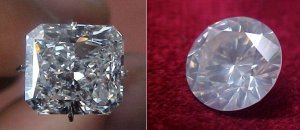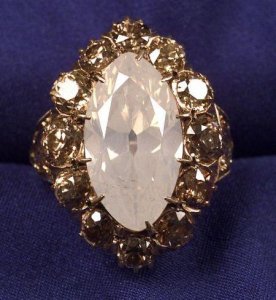You are using an out of date browser. It may not display this or other websites correctly.
You should upgrade or use an alternative browser.
You should upgrade or use an alternative browser.
inclusions and light output
- Thread starter DND168
- Start date
- Status
- Not open for further replies. Please create a new topic or request for this thread to be opened.
JohnQuixote
Ideal_Rock
- Joined
- Sep 9, 2004
- Messages
- 5,212
An inclusion that interferes with light performance could be a significant/large cloud. If it was prominent enough to 'set the grade' it could influence performance. It would have to be very big however.Date: 10/24/2005 11:55:38 AM
Author:DND168
Will inclusions on stones affect how light reflect out of it? meaning if a S12 affect the results of the brilliancescope analysis?
Thanks.
- Joined
- Sep 3, 2000
- Messages
- 6,746
The light coming back to your eye should be altered by inclusions in an accurate system. Certainly, Brilliancescope does detect something meaningful in the way of inclusions interfering with light return, but I have no idea if it is capable of fine distinctions about such things when the inclusions become small and less visibly obvious.
We all have doubts about light return calculated based on measured physical parameters. How will those systems cope with large inclusions or small inclusions?
We all have doubts about light return calculated based on measured physical parameters. How will those systems cope with large inclusions or small inclusions?
JohnQuixote
Ideal_Rock
- Joined
- Sep 9, 2004
- Messages
- 5,212
LOL. Val, you caught me pre-edit. Intended to put 'SI and above' and 'strong lab' qualifiers in, since the OP question was about SI2. Alas, I didn't 'include' them (get it?).Date: 10/24/2005 1:22:21 PM
Author: valeria101
YeahDate: 10/24/2005 1:15:44 PM
Author: JohnQuixote
The only inclusion that could interfere with light performance would be a significant/large cloud.
So, what did the clarity ratings wind up being on those lovelies?
I am guessing the one on the right could even be VVV-Strong Blue Fluorescence, not clarity.
- Joined
- Sep 3, 2000
- Messages
- 6,746
I think I''d agree that visible differences in measured light return would only come from large clouds, large inclusions or stong UV fluorescence. However, while the question pertained to SI2, the meaningful answer should be that inclusions COUNT, but how much depends on exactly how they affect light. When inclusions can be seen with 10x but not with the naked eye, any one of them probably plays only a tiny role, but exactly how many tiny inclusions is deemed a cloud or a large cloud? This is subjective and best left to an accurate system to MEASURE. If the decrease is insignificant, then one might casually say there is little or no effect. Even when there is a slightly visible effect, it may not cause someone to prefer a different diamond.
We don''t have all the answers when it comes to subjective grading. What we do have now are more and better ways to relate what is taking place in an honest way. Then the customer has an even chance of making a fair choice.
We don''t have all the answers when it comes to subjective grading. What we do have now are more and better ways to relate what is taking place in an honest way. Then the customer has an even chance of making a fair choice.
JohnQuixote
Ideal_Rock
- Joined
- Sep 9, 2004
- Messages
- 5,212
Date: 10/24/2005 1:37:41 PM
Author: oldminer
I think I''d agree that visible differences in measured light return would only come from large clouds, large inclusions or stong UV fluorescence. However, while the question pertained to SI2, the meaningful answer should be that inclusions COUNT, but how much depends on exactly how they affect light. When inclusions can be seen with 10x but not with the naked eye, any one of them probably plays only a tiny role, but exactly how many tiny inclusions is deemed a cloud or a large cloud? This is subjective and best left to an accurate system to MEASURE. If the decrease is insignificant, then one might casually say there is little or no effect. Even when there is a slightly visible effect, it may not cause someone to prefer a different diamond.
We don''t have all the answers when it comes to subjective grading. What we do have now are more and better ways to relate what is taking place in an honest way. Then the customer has an even chance of making a fair choice.
There seem to be 2 answers evolving here.
One has to do with the SI2 clarity grade, implying conventional grading. In this situation, if the grader worked for a strong lab, he/she would make conventional - and subjective - judgments with a 10x loupe. Inclusions other than a cloud, large enough to influence performance as seen by the grader, would call for a clarity grade lower than SI2.
The other answer, more meaningful to this thread perhaps, relates to the OP''s question about Brilliancescope results. It''s fair to say that inclusions, no matter if seen with the naked eye, at 10x or at 100x could influence light performance in ''some'' way when measured by a machine like BS, Imagem or Isee. For positive? For negative? For neutral?
The issue of clarity overlapping performance is not new, but at what point does it become significant? At what point does it become adverse? When is it necessary to report? Can the conventional grader at the lab make these distinctions in a practical sense with a 10x loupe?
- Joined
- Sep 3, 2000
- Messages
- 6,746
"The issue of clarity overlapping performance is not new, but at what point does it become significant? At what point does it become adverse? When is it necessary to report? Can the conventional grader at the lab make these distinctions in a practical sense with a 10x loupe?"
Exactly!. In gemology we face such issues frequently when it comes to what constitutes full disclosure versus reasonable disclosure. When is there enough of something to say it is there? When is there enough of something that makes a difference to experts? When is ther enough to say anyone should be able to tell the difference even with little training?
We are on the right road to making decisions on how to reveal what needs to be and also what should be revealed. It is a rather long road with no end in sight. Along the way, we make progress in doing some of the right things. Maybe that's the best that we can do in the environment we live and work in.
It is certain that eye visible blemishes will diminish light return. It is also certain that VVS2 and better clarities have no measureable differences on light return. The gray areas are VS1 into the SI2 (eye clean) clarity grades. How much individual blemishes reduce light return is not fully known at this time. Logic dictates that few inclusions would serve to improve measured light return and that nearly all would rather tend to reduce light return. How much? We are not there yet. Maybe when we take direct measures of stones and then put their physical measurements into light prediction machines we can mine the date to see how much is lost due to inclusions not envisioned in the modeling devices. I know this can be done, but it is not yet being done. I think our eyes do a very good job of discrimination already, so I don't know how important this info will be to anyone who can physically examine a diamond in person. It may prove quite useful for Internet shoppers.
Exactly!. In gemology we face such issues frequently when it comes to what constitutes full disclosure versus reasonable disclosure. When is there enough of something to say it is there? When is there enough of something that makes a difference to experts? When is ther enough to say anyone should be able to tell the difference even with little training?
We are on the right road to making decisions on how to reveal what needs to be and also what should be revealed. It is a rather long road with no end in sight. Along the way, we make progress in doing some of the right things. Maybe that's the best that we can do in the environment we live and work in.
It is certain that eye visible blemishes will diminish light return. It is also certain that VVS2 and better clarities have no measureable differences on light return. The gray areas are VS1 into the SI2 (eye clean) clarity grades. How much individual blemishes reduce light return is not fully known at this time. Logic dictates that few inclusions would serve to improve measured light return and that nearly all would rather tend to reduce light return. How much? We are not there yet. Maybe when we take direct measures of stones and then put their physical measurements into light prediction machines we can mine the date to see how much is lost due to inclusions not envisioned in the modeling devices. I know this can be done, but it is not yet being done. I think our eyes do a very good job of discrimination already, so I don't know how important this info will be to anyone who can physically examine a diamond in person. It may prove quite useful for Internet shoppers.
- Joined
- Aug 29, 2003
- Messages
- 15,808
Date: 10/24/2005 1:27:11 PM
Author: JohnQuixote
So, what did the clarity ratings wind up being on those lovelies?
Both SI2 and no fluorescence involved. that really was cloudy with something all over. I kept the freak picture for the record.
It sounds like that was by no means alone. A recent auction listing I happened to bump into cited a 20ish carat oval like that. I can only imagine the enthusiasm of the seller stuck with it

Someone must like them though... this one below came up at Bonhams'. I wonder when these start to be called 'fancy white' instead of getting a lower clarity grading?
- Joined
- Aug 29, 2003
- Messages
- 15,808
- Status
- Not open for further replies. Please create a new topic or request for this thread to be opened.
Share:
Past, Present, Future: The Meaning of Three-Stone Engagement Rings
Past, Present, Future: The Meaning of Three-Stone Engagement Rings - 04/14





300x240.png)